#the power of color theory and composition
Explore tagged Tumblr posts
Text
an interesting thing that i've realized through playing the sims: the art that i prefer to decorate a home with does not equal the art that i love.
what i mean by this is that while i'm putting a room together, and i'm considering all the lines and colors and shapes and cohesion of everything, 9 times out of 10 the classical portraits that i flock to at the museum do not work as well on the wall as the canvas with the paint splatters on a simple gradient background. it just doesn't. and part of me is upset about this because i am an absolute whore for baroque art. like, vermeer? gentileschi? bernini? render them unto me that i might gaze upon their beauty.
but would i put a copy of Judith Slaying Holofernes in my living room? no, it clashes with the upholstery.
too dark for the hallway.
sending mixed messages in the dining room.
so yeah, idk, having a big funky color block a la rothko has some aesthetic value on a day to day home use basis, and i'll probably die mad about it loll
#landscapes are like. the exception to this rule.#but only for certain aesthetics.#the power of color theory and composition#absolute witchcraft#like okay modern artists#i see you#i'm still mad about it#but i do see you lol#lp bitches#lp forgot to mention they're an art snob#whoops#and to be fair#the portraits do work with some aesthetics#but it's not to my taste.#personally.#like idk i like clean lines.#it gives me the illusion of being organized.#i apologize to everyone i know who hates rothko btw#which includes me#no one is following me for my trash takes on art i know#i could actually go into why those pieces work#including the ones i don't like#but i also once had to give a spoken book report on a book i hated#as if i liked it. because i misread the assignment and thought i was there to trash it.#nope.#found that out right as i started. teacher stopped me like UHHH.#and i just adapted lmao#so yeah i can devil's advocate like a boss. not that he needs it.
17 notes
·
View notes
Photo

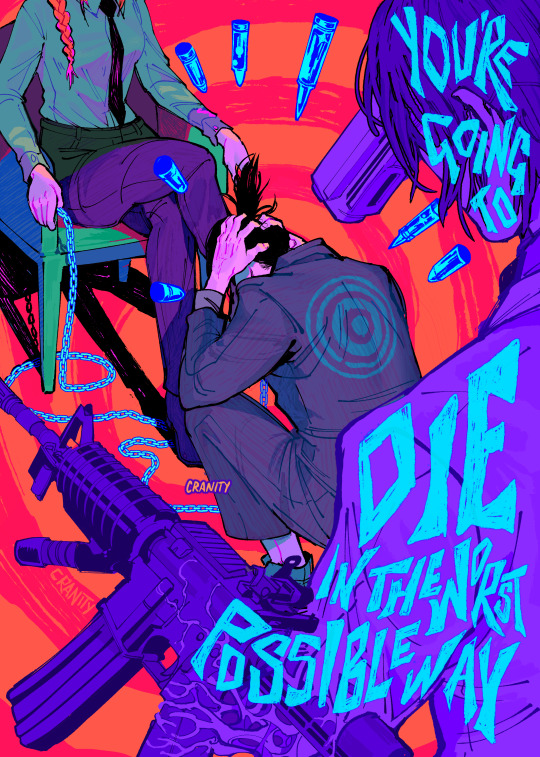
THE FUTURE RULES!
#this is literaly so mesmerizing#the color theory?? the composition??? THE DETAIL???????#pukes (in a good way)#csm spoilers#<- ahead AUAGAHAHSGSHSHH AKI 🙁🙁🙁🙁🙁🙁🙁🙁🙁🙁🙁🙁🙁#i love him too much to the point where i want to die everytime i see him#ik i talk ab how jawdroppingly mouthwatering ly fingerlicking hot and pretty he is but like#he also makes me so sad bc he’s so Doomed it’s so tragic 😭😭😭#just like. the way his goals changed from defeating the gun devil to just ensuring power and denji had a good life#The Older Brother ever#AND THE TARGET ON HJS BACJ????#this reminds me i saw a post yesterday showing how aki had also been killed by the gun devil#his name was in the list n i hadn’t even noticed that while i was rereading#TAHT MAKES IT SM WORSE#AND THEN HE HAD TO BECOME THE VERY RHING THAT WIPED OUT HIS ENTIRE FAMILY AND BROUGHT HIM TO DEVUL HUNTI IN THE FIRST PLACE???#he came full circle in the worst way possible 😭😭#cough gun fiend aki is so fine cough#he has my posture#imagine if he became a fiend like power did#THAT WOULDVE BEEN SM BETTER 😞😞😞😞😞😞😞😞😞😞😞😞😞😞😞😞😞😞😞😞😞😞😞😞#nothing makes me more upset than csm and fujimoto the devil himself#aki my beloved 💔💔#rb#PLEASE HES SOS SIDHDVEJSDHDB I JUST WANT HIM TO BE HAPPY 😭😭😭😭#heart hurts#we’re not even gnna talk ab makima.
18K notes
·
View notes
Text
Hi, welcome to Buck just had his oh moment and the color theory of it all.
Usual shoutout to @stagefoureddiediaz because being mind meld with her is what's getting me here lol
First, I'm gonna break my own rule and give too much power to the showrunners, I know I keep saying not to, but hear me out. Buck, Bothered and Bewildered is on Buck's pov, right? That was made clear by the episode and then confirmed in interviews that that was the vision, and well, Tim also said that that scene was from Buck's pov, it's all about Buck's reaction and how he will go crazy about this because he's abandonment issues personified, that is also confirmed with the way we don't see what Eddie is doing until he tells Buck, we are learning things at the same time as Buck is.
Okay, well, why am I going back to 704? Well, Buck's fear of losing Eddie (I don't care what Buck says, he wanted Eddie's attention) made him go completely batshit crazy last time. But it also triggered something really important: Buck's bisexuality. And they just repeated that trigger, but this time with Buck choosing to walk in.
They repeated the bt first kiss structure but with Buck making the choices that create that change. The bt kiss, Buck is working on some bills, Tommy shows up, Buck is spiraling because of Eddie, Tommy kisses him, Buck has the bisexual realization. The 808 scene, Eddie is working on the houses, Buck shows up, he's spiraling about Tommy, Eddie reveals something, and Buck is snapped into the realization. Important thing to notice is that Buck still doesn't fully understand the depth of what his relationship with Tommy showed him about himself, so Buck still might not understand the impact of what his abandonment issues just told him while he was sitting on Eddie's couch. And it's all on Buck's pov.
But Anna, you said color theory.
I'm getting there. Because, well, the bt kiss is blue and red.


Same as 808. So we are evoking the same feeling, especially because of Buck's short sleeves and the buttons (and not a white shirt under this like he had all season lol)


And thinking about the blue and yellow coding Buck's bi arc, he worked his way to lighter blues. He starts with the navy blue colors until that lighter teal tone from the coming out scene.

It's also interesting that in the scenes that are about Eddie in a sense, when he's talking to Maddie and he got it right about it being about Eddie, and the coming out scene being about their friendship, are lighter colors along with Buck matching his background. We don't have the yellow elements but we have that cohesion on the frame composition. (I guess the 606 hoodie also counts since blue and green theory but I don't want to make another image now).

If you're new here, the theory is that Buck worked his way to his blue from darker colors, his blue being the color he is wearing during the coming out scene (and Eddie will find his yellow, but we are not talking about Eddie).
We are back in the darker blue but the composition of the scene is lighter. Buck is literally in front of the light as he is talking to Eddie in the kitchen, and it's the middle of the day.


He matches the background, the couch, the Texas frame, the lighting is also a lot colder than it usually is in Eddie's house. And it's also very important that he is on the couch, because yay couch theory.
But Anna how does any of this prove anything?
Well, Buck is working his way back to his blue while in the darker colors, because while he got the bisexuality part right, Tommy wasn't the right person, and he's finally back in the light, we don't have the dimmed light and the obstruction of his face created by the shadow, dare I saw Buck is finally starting to see things clearer.
But why am I so sure? The shirt he was wearing today?

Same color but in a darker shade than his blue.

Buck is back on the discovery feeling that comes with the darker blue but this time he's in the correct hue, he just needs to get to the right shade, and he just figured something out.
Abandonment issues personified just had his oh moment about Eddie at the thought of losing him permanently, sitting on Eddie's couch while wearing his blue.
Other things to notice, Buck knocked but walked in before Eddie could get to the door, he used his key and the knocking was just to let Eddie know he was there, Buck is the one who suggests moving to the couch and the couch ties it back to the couch theory and the 601 dinner, dare I say that even Buck offering to bake for Eddie and the cooking aspect of it all, and the idea that the couch is home and home is a person and for Buck that's Eddie.
Something else is the way that we finally see someone eating whatever it is Buck is stress baking. Madney don't eat at the loft and the chief interrupts them at the firehouse. Eddie on the other hand is DIGGING into those. And food in 911, in media in general, is about connection, and is very pointedly about love here, and the whole stress baking is great because the kitchen is Buck's safe space, he cooks for people he loves, we see that from when Maddie comes back, to the pointed way he gets take out for his parents in 610, to the lasagna, making chilly with Bobby, cooking for the house on 709 and getting Bobby's approval. And the fact that we are getting Eddie eating what Buck's nervous state is creating while allowing Buck to just go through his kitchen to make more because he is not about to not accept every part of Buck Buck offers him is important.
The fact that Eddie isn't objecting to Buck rummaging around his kitchen is also important in the way the show uses Eddie's house in a meta way, kinda like the way the show uses the loft to match Buck's spirits in a sense, how the kitchen is his heart and for family, how the living room ends up being for guests and it's made pointed about the couch his mother bought "for his guests", Eddie's kitchen and the whole way it's the space Eddie allows himself to be vulnerable but there's the thing of honesty, the core of who Eddie is is tied to the kitchen, and the fact that he's just letting Buck move around like it's his kitchen ads a lot. Buck is the only person who walked into the house through the back door, Buck has a key, Buck has been in every room (except the bathroom but I think they are saving that for buddie canon), that's home for him too and Eddie never thinks to question and Buck never thinks to doubt it ("this is Eddie's house, I'm not really a guest").
Anyway, Buck oh moment real. Buddie 8b real. Color theory got me so high I'm wondering this is what doing hard drugs feels like. I think this is all I have to say. I might come back, who knows? I don't.
If you read this I love you.
taglist (interact with this post if you wanna get tagged)
@sparkedblaze @caw-salem @dreamofsomepiphany @100ceruleaneyes @linus-lucy @chaosqueery @gina-spike @chimchiminie98 @elvensorceress @singitforthegirls @dangerpronebuddie @182daysof @steadfastsaturnsrings @sparklespiff @inell @miles--to--go @jesuisici33 @wolfdeans @lunarsolar1 @joshwritesfics @glasscities @kejfeblintz @stagefoureddiediaz @mosaicstardust @eddiedisasterdiaz @hermioneindisguise @queerprincesseddiediaz @lookforanewangle @becausebuckley @lemotmo @thenainitaldisaster @epiaphany @trudayss @shelfthe-reader @alliaskisthepossibilityoflove @buckgettingstruck @scoupsahoy @the-whispers-of-death @iced-coffee-jesus @izzysbeans @starkytower @thegeekcompanion @sunflower-eddiediaz @bucks-daddy-issues
@dingdongfries @angelcamael
190 notes
·
View notes
Text
Overanalising Moral Orel: Clay, Bloberta and the Colour Theory
p.1 Clay
Interesting thing about visuals in Moral Orel for Clay and Bloberta is that in Help, upon the first meeting, Bloberta wears red and Clay wears blue – in colour theory those are split-complementary colours, the are not exactly opposites, so the don't contrast of clash against each other.

Clay's light blue is cooler, more purple-ish, and provides soothing visual effect to Bloberta's bright warm red-orange.
In design, the cool colors can help soften the intensity of the red, creating a balanced and visually striking composition. In this moment they are more in harmony than they will ever be.
By the end of Help, they are married and utterly unhappy. While Bloberta sticks to her reds even after marriage, Clay moves to greens. The are truly complementary now, but also absolute opposites.

In visual perception there's also such phenomenon as impossible colours. These are the colours that are on the different wave length and thus cannot be mixed during the initial perception. And look who's on the list:

So, visually Clay and Bloberta stand in stark contrast and by no means are mixable. As if it's on purpose. You see, it's notable how Bloberta stuck to her colour identity through the series, while Clay shifts all around the place. It's green > light blue > green/brown. As if he changes his personality on purpose to be farther and opposite to Bloberta.
We know he has a crappy sense of Self, but it is also all over the place, how he creates his Identity based on who is near, who is wanted and who's not. In private environment he tries to distinct himself from Bloberta as far as possible. It's to spite her, to show her how much he doesn't want to be tied to her, but mainly it's for him – a way of protection and masking for his Self. His identity is of Bloberta's opposite.
There's also a narrative meaning for Clay's green. It's immaturity, childishness. He wore green in Passing, he started off in green. A short period we see him in blue is rare moments of relative wellness. He is starting to come to his own meaning, living by himself and for himself. He was also trying to distinctly set himself in this world, establishing a particular colour identity. Possibly, if he'd never married Bloberta, there would've been something different in his style maybe darker blue. Light colour and also his appearance and demeanor (a stray curl) is also symbolic of his remaining innocent and naïvity.
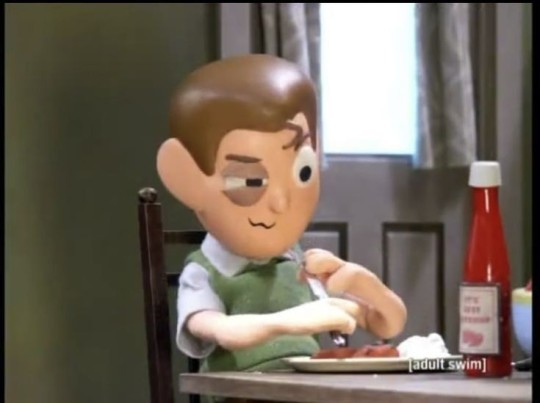
Once he goes back to greens, it also feels like he makes a huge step back from his initial route. From there on he either stays in place and doesn't grow as a person or spirals into something worse.
He also adopts brown in his clothes. To work, to church, when they have guests or in winter – he wears brown suit or coat. It's a formalwear, there's nothing strange about it, but interestingly, it's his wear for an outer world. It's neutral, uncharacteristic, a Persona he needs to show to the community to give off the impression of competence and respectability. Bloberta, on the other hand, again keeps her red. They look very homogeneous together in this composition.
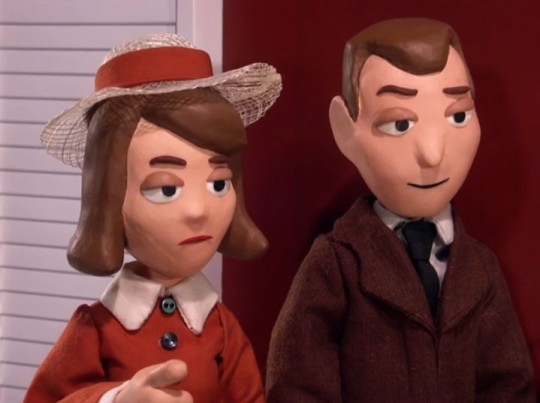
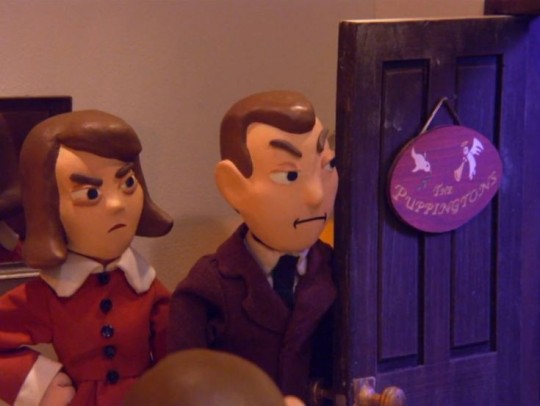
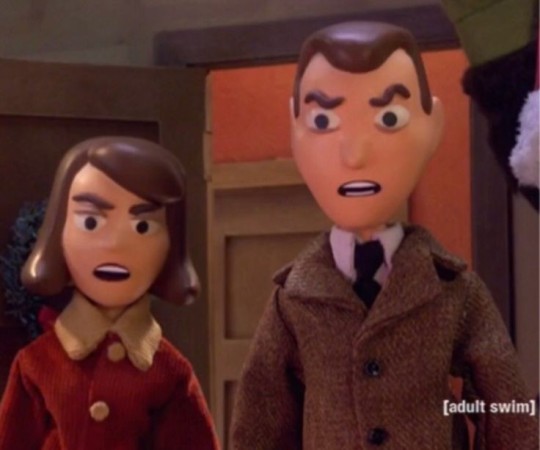
Clay's brown is actually a darker, less saturated hue of red. Position wise, they are the same, analogous here. It's also a part of the Persona – unity of husband and wife. They don't clash visually, quite opposite – the one is an extension to another. Exactly what the society expects from a nuclear family unit. When they are positioned like this, they also get along sometimes, they are less focused on getting on each others nerves and more on presenting to the community, so they are able to put personal attitudes aside and actually chill.
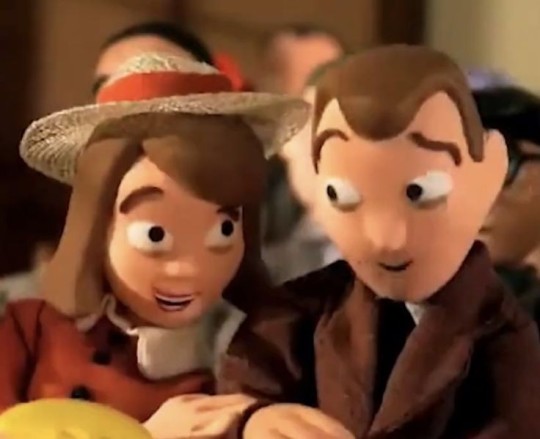
The complete opposite is Clay's Study. Here, he's alone. It's and established power fantasy for him, a place of delusion and unreality. It's everything he longs to be but is not. In his study he wear a deep dark-red dressing gown. In this environment we usually see his truest self – his intentions, his attitudes, his feelings etc. Red as a personal colour and as a scene undertone sets the impression of power. But the truth is – he never has it. All the disasters of his behaviour, that are set in real scenarios are carried out by his real Personas – in green or brown. What's hidden – is in red.
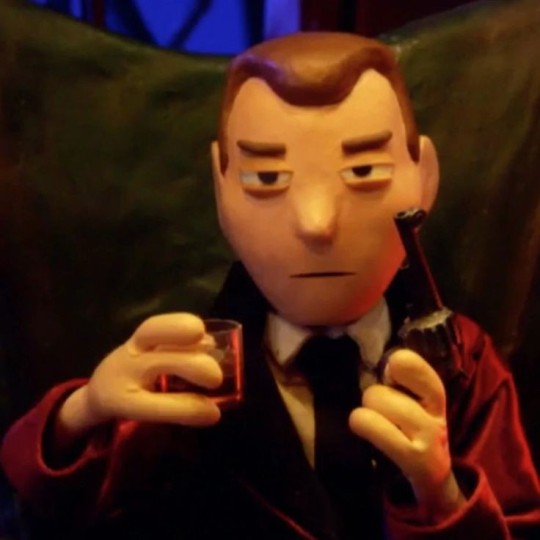
It follows him even where he tries to conceal it. Bar scenes, hunting trip spiral scene, Danielle's flat scene – he's supposed to be a Persona, but the red shadows are there outing what he wants to hide.
(Upd: i forgot that Passing, up to Angelas death, is also with red undertone. For Clay red is a colour that signifies disaster and unhappiness. Red is everywhere where he is about to act out, prompted by his misery. It's like and angry sorrow, that follows him. It's such a cruel joke that he even married a woman who is in red.)
Red is a colour of his ideal self but also of his self-destruction. It notable for the way those two meanings always go hand-in-hand. Even in his ideal fantasy he doesn't allow himself to achieve happiness. Red is a colour of two forces that tear him apart and send him into a spiral over the counter of the series.
But Clay's red, unlike Bloberta's, is also unstable and irregular. It's notable how all his colours are on the surface level, its a piece of clothing that is put on something. Green cardigan – a mask for Bloberta, red dressing gown – ideal self for himself, brown jacket or coat – a mask for the community. It's all a wrap for his real self, that it too raw and painful to show to the world. Underneath his colours is white – blank and reflective. It's certainly reflects Clay's shallowness – underneath all that colour is nothing, white, blank space that is occasionally filled with something to fit a the specific situation. White is his absence sense of self. White is his actual subconsciousness. Only time he wears white is to bed. And in his sleep is also the only time when his actual suppressed self resurfaces foe just a bit, for us to see.

What we were able to read through his colours themes is that he is a man with a damaged sense of Self and a fake personality, that is never authentic to his true self. It leaves him feeling vulnerable and exposed so he reacts with anger and anatgonism to protect his core. His weak sense of self leaves his susceptible to many kinds of influence – his initial reaction is to confirm, even if he'll resent it in the end. He always adopts a personality according to the relationship of situation he is in.
So Listen, maybe the suit is just blue or maybe no, maybe it actually represents something. This whole thing can be all bs. I also understand the character design process and how main characters need to be recognisable. We are overanalising shit here, sir.
Next's Bloberta.
p.2
167 notes
·
View notes
Text
One of my many fantasies regarding "going back in time and take advantage of future knoledge" is about the creation of art.
Imagine going to the past, say 1920 and making a movie making use of all the collected film theory knowledge of an entire century. We understand mise en scene much better now, we understand how to direct the viewers eye, we understand composition, how to write naturalistic dialog. The camera had just been invented, they werent too sure what to do with it yet.
Or think of videogames
I would love to go back and take full advantage of what we currently know about effective UI design, kinaesthetics, color theory, player psychology, quality of life, ludonarrative, and such.
Like, people werent just learning how to implement games on computers, they were learning what a videogame is and how to design them.
A lot of the power and entertainment of games today is because we just have flat out better hardware,tes, but I really wonder what you could extrude from the limited tools of the day armed with just the theoretical knoledge and the techniques of the future with regards to game design, or movie making.
Is like the pasteurization process, we had the technology for it for millenia, is just that nobody thought of it. It was merely a conceptual leap.
14 notes
·
View notes
Text
Daima EP.6 (Spoiler) Review/theories
• HOLY SMOKES, the art direction! Lighting/colors/composition=chef's kiss.
• So Panzy really does wear a collar. Based on the short scene where a Gendarmerie scanned her collar, it's not a fake & fully functional. (Saddening) Wonder if that will somehow impede her ability to travel between worlds. Shin kinda looks like he's gonna do something about it in the next EP preview.
• So the "Kaio"/"Kaio-shin" titles are only given in the outer world, where they are viewed as "gods". They also don't get paid. Makes sense. The Kaio-shin, at least, have never come off as materialistic.
• Panzy essentially confirmed that the entire Demon Realm is smaller than an average universe (outer world), which I suppose checks out, given it only contains 3 worlds.
• Forgot to mention this like, 2 reviews ago, but the symbol that the Gendarmerie sport is clearly based on the Tertian Oculus.
• Goku's bounty is only 10 gold coins? BOO! 3 of that'll go to the routine offering anyways, so you're really only getting 7.
• Perhaps Goku will have to walk around as a Super Saiyan for a while to remain incognito. It would definitely help his body get used to it, Cell saga style.
• Originally, in the Dragon Ball Kanzenshu, the Kaio-shin were stated to have been born from fruit from 1 massive tree. It's now been retconed to 5 big (Onion shaped) Glind trees. Which, in my opinion, is fine since, as far as I know, the Kaio-shin birth origins have never been verbally stated in a Dragon Ball show prior to this scene. It's still a neat origin. It also implies we might see a few baby Kaio-shin in the 2nd world. "Born every few centuries" huh.
• Goku making us all realize we've never seen Shin eat & have only seen him drink drink liquids Namekian style. Makes sense, since the Glinds & Namekians originated from the 2nd demon world.
• So any Kaio-shin born from the same Glind tree are considered siblings. That's very cute.
• "Glinds don't have genders" implies that they essentially choose their own physical attributes/appearance, likely via that body altering magic we saw Shin use in EP 3. So... Y'know... Slay, Dr Arinsu.
• Since the 3rd Demon world has 2 suns, that implies that real night time is super brief, & that the night sky we saw in EP 3 appeared in the very dead of night.
• Panzy can fly a plane.
• Lmao, Supreme King Gohma matchboxes. I want one.
• Panzy's sleeping bag is SO CUTE! Hope they sell them IRL someday.
• Glorio implies that by living in the 1st Demon world, he, as a 3rd world demon, need not adhere to the collar law & whatnot. Makes a lotta sense. Privilege.
• We finally met the cute, silly(stinky) Minotaur from the OP. Clearly another one-off character we probably won't see again. So expressive though. I liked him. The way he left had me belly laughing.
• Through Glorio vs Goku we see that Glorio's strength is somewhere around Goku's full power at base form, we see how King Gohma & Degesu could mistake ki blasts for magic, that Goku has acclimated to the dense air just fine already, & that Glorio is a lightning magic user.
• While knowing Hybis is coming to pick up the gang on Earth is both reassuring & kills any possible tension that would've been there had the scene where Shin's old plane breaks down was shown before introducing us to Hybis, I gotta say... I feel pretty bad for Bulma here. She worked so hard & seemed so excited. But she'll probably shrug this off. She's Bulma.
• Oh, & of course, I was right about Glorio working for Dr Arinsu.
#dragon ball#dbz#dragon ball z#db#dragon ball daima#daima spoilers#db daima#dragonball daima#Daima#daima panzy#daima glorio#son goku
18 notes
·
View notes
Text

Title: Sigilcraft Mechanics: Metasigils, Hypersigils, & Knot Magic
Suggested Reading
Sigilcraft: How-to Conceptualization Vs. VisualizationAnchorsEnergetic ConstructsIntermediate Energy WorkIntro to GnosisVisualization: Effective PracticeCorrespondencesThreshold Theory Basics of Spellcasting Spell Design
CW: This article discusses | || || |_. iykyk
Sigilcraft, Metasigils, & Hypersigils
When first getting into sigilwork, you may stumble into the practices of meta/hyper sigils. Metasigils are things like sigil-chains and spell circles, or multiple sigils that are connected or combined in order to create a more specific purpose. Hypersigils are nebulous connections made between concepts and intent that are embedded into the media. Hypersigils operate off the exact same mechanics as regular sigils but they are carried through a different, more expansive, vehicle. Rather than using lines and symbols to carry their purpose, their purpose is programmed through imagery, theme, composition, color theory, mathematics/numerology, and/or energy work. Sigilcraft, Metasigils, and Hypersigils represent intriguing aspects of contemporary occult practices, drawing upon psychological frameworks and symbol manipulation. Sigilcraft involves the creation and activation of sigils, which are abstract symbols charged with personal meaning and intention. These sigils serve as condensed representations of desired outcomes or transformative states. Rather than relying on explicit intentions, practitioners engage in a process of symbolic encoding to tap into the subconscious and evoke change.
Metasigils take sigilcraft a step further by incorporating multiple sigils into a larger, interconnected system. This system aims to capture a complex web of desires, beliefs, and archetypal influences. Metasigils serve as composite symbols that harmonize various facets of the practitioner's psyche, creating a unified expression of personal goals and aspirations. Through the interplay of multiple sigils within a Metasigil construct, practitioners seek to engage with deeper layers of their consciousness and facilitate transformative shifts.
Hypersigils push the boundaries of sigilcraft by expanding beyond static symbols into dynamic narrative frameworks. Hypersigils encompass a multidimensional approach, incorporating elements of storytelling, art, and personal mythology. They function as immersive vehicles that transport practitioners into a narrative world where their desires and intentions unfold. Hypersigils intertwine the symbolic power of sigils with immersive narratives, fostering a heightened level of engagement and identification. Through the ongoing interaction with the narrative construct, practitioners immerse themselves in a self-created reality that facilitates profound personal transformations.
The underlying psychological mechanisms behind sigilcraft, Metasigils, and Hypersigils are rooted in the power of symbolism and the subconscious mind. By engaging in symbol manipulation and focusing attention on the sigils or narrative constructs, practitioners tap into the reservoir of the subconscious, which is receptive to symbolic language and imagery. This process operates on the principle that the subconscious mind is more receptive to indirect communication, bypassing conscious filters and allowing for greater potential for change and manifestation.
Within this psychological framework, sigilcraft, Metasigils, and Hypersigils can be seen as tools that interface with cognitive processes, including attention, belief formation, and intentionality. The process of creating, activating, and interacting with these symbolic constructs involves a deliberate manipulation of cognitive processes to influence perceptions, motivations, and behaviors. By engaging with sigils, Metasigils, and Hypersigils, practitioners harness the power of suggestion, amplifying the psychological impact and aligning their subconscious processes towards desired outcomes.

Historical Contributions
The contributions of Paracelsus (1493-1541), Austin Osman Spare (1886-1956), Marsilio Ficino (1433-1499), Abu Ma'shar al-Balkhi (787-886), and Zhang Guo Lao (c. 8th century) to the practice and use of sigils, talismans, and amulets were instrumental in shaping the understanding and application of these symbolic tools.
Paracelsus, a pioneering 16th century physician and alchemist, explored sigils, talismans, and amulets within his holistic approach to medicine and metaphysical philosophy. His seminal works, such as "The Book of Seven Seals" and "Philosophia Occulta," elucidated the intricate connections between the natural and spiritual realms. Paracelsus emphasized the utilization of symbols and objects to harness and channel the innate healing powers of nature, promoting the idea that the physical and spiritual aspects of existence were intimately entwined.
Austin Osman Spare, an artist and occultist, brought a unique perspective to sigils, talismans, and amulets in the early 20th century. In his influential work, "The Book of Pleasure," Spare developed a method known as "The Alphabet of Desire." This system involved the creation of personalized sigils as a means of manifesting one's desires. Spare's approach emphasized the integration of sigils into individualistic practices, wherein practitioners could tap into their subconscious and project their intentions into the symbol, without relying on external correspondences or established magical systems.
Marsilio Ficino, a 15th century Italian philosopher and astrologer, made significant contributions to the understanding and application of talismans. In his notable work, "De Vita Coelitus Comparanda," Ficino explored the concept of celestial correspondences and the use of talismans to align oneself with the cosmic forces. He believed that talismans, charged with celestial energies, could serve as conduits to bring about specific effects or virtues. Ficino's emphasis on the inherent connections between the celestial and human realms paved the way for further developments in talismanic practices.
Abu Ma'shar al-Balkhi, an 8th century Persian astrologer and astronomer, explored talismans and their relationship with celestial influences. In his extensive writings, including "The Book of the Thousands" and "The Great Introduction," al-Balkhi explored the creation and application of talismans based on astrological principles. He believed that the proper alignment of planetary influences and the selection of auspicious times were crucial factors in the efficacy of talismans. His works provided a structured approach to the utilization of talismans in magical and astrological practices.
The fangshi (Occultist or Alchemist) Zhang Guo Lao, a legendary figure in Chinese Taoism during the Tang Dynasty (7th century), is associated with the creation and use of talismans. Though historical details of his life are uncertain, his role in Chinese folklore and Taoist practices is noteworthy. Zhang Guo Lao was believed to possess the ability to create and utilize magical charms and talismans. He was associated with the tradition of Taoist magical arts and was considered a master of talismanic practices.
These individuals, each with their unique perspectives and contributions, shaped the understanding and practice of sigils, talismans, and amulets. Paracelsus's holistic approach, Spare's individualistic methods, Ficino's celestial correspondences, al-Balkhi's astrological insights, and Zhang Guo Lao's mythical influence all played a significant role in the development and evolution of these symbolic tools. By exploring the interplay between natural and spiritual elements, these historical figures expanded our understanding of how sigils, talismans, and amulets can be utilized as practical and symbolic aids in various metaphysical, mystical, and magical practices.
The concept of hypersigils emerged in the field of chaos magic, and it was popularized by the occultist and writer Grant Morrison. Grant Morrison is often credited with introducing and developing the idea of hypersigils in his comic book series "The Invisibles," which was published from 1994 to 2000. Morrison expanded on this idea and proposed the concept of hypersigils, which extended the creation and activation of sigils to more complex and immersive forms of media. In "The Invisibles," Morrison incorporated his personal beliefs, desires, and intentions into the storyline, characters, and themes of the comic series. By doing so, he believed that he was effectively creating a hypersigil that would have a profound impact on his own life and the world around him. Morrison is quoted: “"The 'hypersigil' or 'supersigil' develops the sigil concept beyond the static image and incorporates elements such as characterization, drama, and plot. The hypersigil is a sigil extended through the fourth dimension. My own comic book series The Invisibles was a six-year long sigil in the form of an occult adventure story which consumed and recreated my life during the period of its composition and execution. The hypersigil is an immensely powerful and sometimes dangerous method for actually altering reality in accordance with intent. Results can be remarkable and shocking"

Uses and Applications in Witchcraft
The applications of Sigilcraft, Metasigils, and Hypersigils within the models of psychological, spiritual, energetic, and informational witchcraft encompass a diverse range of practices and techniques, each with its distinct focus and approach. Sigilcraft, the creation and utilization of sigils as symbolic tools, finds relevance and applicability in these different models.
In the psychological model of witchcraft, sigils serve as potent vehicles for self-exploration, introspection, and personal transformation. Through the process of crafting and activating sigils, practitioners engage in a form of self-directed psychological programming. Sigils become encoded representations of desires, goals, or affirmations, and their activation acts as a catalyst for subconscious shifts, empowering individuals to manifest desired psychological states or changes within their own psyche.
In the spiritual model of witchcraft, sigils hold significance as sacred symbols that establish connections between the individual and the divine or spiritual realms. Through the process of crafting and consecrating sigils, practitioners forge a connection with spiritual forces or deities, invoking their guidance, protection, or blessings. Sigils become conduits for spiritual energy and serve as focal points for devotion, meditation, or ritual practices, facilitating communion with the sacred and the cultivation of spiritual growth. May also incorporate astrology to aid in constructing this connection.
Within the energetic model of witchcraft, sigils function as energetic constructs that interact with subtle forces and channels of energy. By infusing sigils with a specific energetic signature, practitioners direct and manipulate energetic currents to influence specific outcomes or to affect the energetic balance within themselves or their environment. Sigils become energetic engrams, harnessing, transmuting, and directing the flow of subtle energies to bring about desired energetic fluctuations. Due to the pervasiveness of energy within all practices, any media or symbol can be created as, or made into, a sigil.
The informational model of witchcraft recognizes sigils as symbolic codes that communicate and transmit information beyond the conscious realm. In this model, sigils serve as gateways to accessing or altering information within the collective unconscious or the larger informational field. Practitioners employ sigils to tap into the reservoir of universal knowledge, to enhance intuition, or to encode information for purposes of communication, divination, or influencing informational flows.
Metasigils, an extension of sigilcraft, further expand the possibilities within these models of witchcraft. Metasigils operate on a meta-level, encompassing multiple sigils within a unified framework. They represent complex intentions, archetypal patterns, or overarching principles, serving as beacons for desired outcomes or as catalysts for profound shifts on various levels of existence.
Hypersigils transcend the individual sigil and encompass an entire narrative or artistic creation. Hypersigils are multifaceted expressions of intention and passion, woven into a larger creative endeavor such as a novel, artwork, or performance. Through immersion in the hypersigil's narrative or experience, practitioners engage with the intention on a deeper level, blurring the boundaries between the symbolic and the lived reality, thus manifesting desired outcomes or transformations.

Sigilwork As A Concept
The conceptual foundation of sigil magic is functionally the same as non-sigil spellwork. Both are forms of esoteric manipulation, exhibit striking similarities when examined through a purely theoretical lens. Both rely heavily on the deliberate and purposeful application of intent, passion, and gnosis, hinged on the belief that human will, when focused, can incite change in the experienced reality.
Sigil magic operates on the premise that a practitioner, through concentrated trinity of spellwork, invests a symbol, or sigil, with a specific directive or objective. This directive, often personally significant and meticulously crafted, is embedded into the sigil during its creation. This procedure leverages the potent forces of subconscious cognition, energy work, and potentially spirit work to effectuate desired outcomes. The sigil, in this case, serves as an anchor for the working of the practitioner.
On the other hand, non-sigil spell work also hinges on the utilization of the trinity, albeit sometimes without the symbolic component. Such spells, which can incorporate verbal utterances, physical actions, or the use of specific artifacts, aim to manifest a certain outcome by directly channeling the practitioner's will. In non-sigil spell work, it is the act or process of spell-casting that provides the energy which is typically anchored in a physical object or organism rather than a symbolic representation.
This dichotomy between the symbolic (sigil) and the action-oriented (non-sigil) methodologies offers an intriguing insight into the functional versatility of focused willpower in esoteric practices. While sigil magic employs symbols as the praxis for the working, non-sigil spell work instead often utilizes action or ritual which may not utilize this method of symbology. Despite these differences in methodology, both practices exhibit a common underlying principle: the harnessing of will (intention, passion, & gnosis) to effect desired changes. Energizing a sigil, akin to the preparatory stages of a non-sigil spell, involves focusing one's psychological, spiritual, and emotional energy on the emblematic object. This concentration of energy can be analogized to potential energy in the physical sciences - energy that is stored and ready to be transformed or released.
In the final stage of the sigil operation, commonly referred to as activation, the practitioner catalyzes the stored energy, analogous to the casting stage of non-sigil magic. Like a potential energy converted into kinetic energy when a physical object is set into motion, the activation process of an active sigil (see Sigil guide) transmutes the potential 'energy' concentrated in the sigil into a force aimed at manifesting the initial objective. The release of energy in this manner parallels the manner in which a spell is cast in non-sigil magic - a directional release of prepared energy to achieve a desired outcome. They also invariably utilize energy work, subconsciously or otherwise, to program the work towards a specific direction; move the work towards its target; and cause manifestation to a certain degree.
Furthermore, through the Spare method a meme, like the well-known "Loss", starts as an explicitly narrative unit. The original comic strip, that gave birth to the "Loss" meme, encapsulates a specific narrative—a poignant moment in a larger story. When this meme gets abstracted into a series of connected lines (| || || |_), it undergoes a transformative process akin to the creation of a Spare sigil, where an idea or goal is reduced to an abstract symbol.
The process of abstraction is central to this model, severing the explicit link between the signifier (the meme or sigil) and the signified (the original narrative or goal), thereby enabling the meme or sigil to be loaded with new meanings. Through the principle of intertextuality, each subsequent iteration of the meme or sigil can carry additional layers of meaning based on its relationship with other texts or cultural artifacts, further augmenting its power or ability.
When a meme is shared, engaged with, and re-contextualized by numerous individuals across the digital landscape, it can accumulate a form of energy. This propagation, engagement, and subsequent energy accumulation parallel the charging phase in sigil work.
The final aspect of this model concerns the activation of the sigil or the triggering of the meme's energy. When the meme is encountered in a context that aligns with its charged energy—whether that's humor, shock, or another emotional reaction—it discharges this energy, catalyzing a change in the perceiver's consciousness. This change is the operative goal in both meme propagation and sigil magic, making memes an intriguing tool for modern magical practitioners.
This concept is relatively mirrored by spellwork and spiritual practices found in pop-culture magic. Where a spell or being is used in real life. Pop-culture spellwork operates on similar principles to traditional spellwork, with pop culture entities taking the place of classical magical symbols or archetypes. For instance, a practitioner might call upon a character from a popular film or book, seeing in that character a symbolic representation of the qualities they wish to evoke or the changes they aspire to make. This is akin to how a sigil operates: an abstracted symbol carrying potentially accumulated meanings, invoked to initiate a desired change. Spirits conceptualized this way can become what is referred to as an egregore, or a thoughtform, which is forged in the idea of “the collective consciousness”. These entities, much like memes, are imbued with a certain collective energy derived from the shared cultural understanding and emotional investment of their audience. Intertextuality and abstraction play significant roles in both practices. In pop-culture spellwork, the entities used are intertextual, their meanings and energies derived from their relationships with other cultural artifacts. In pop-culture spiritwork, the practitioner often abstracts the entity from its original context, enabling it to carry new or additional meanings.

Applications of Sigil Conceptualization via Gnosis
The application of sigil conceptualization via gnosis demonstrates its efficacy and adaptability in various magical practices, such as knot magic, candle magic, rune magic, and kitchen magic. Gnosis, referring to a state of deep intuitive insight or focus (typically propagated through the cultivation of a conducive headspace), serves as a powerful catalyst for sigil work. The process involves the practitioner entering a heightened state, transcending ordinary awareness to connect with their intention and passion.
Knot magic, a practice found in diverse cultural traditions, involves the tying of knots to manifest desired outcomes. Through the use of knots, imbued with symbolic significance, practitioners harness the power of intention and gnosis to weave their desires into the fibers. By tying and untying knots with purposeful focus, the practitioner establishes a tangible representation of their intention through abstraction, activating the energetic potential of the work. This is nearly a 1:1 correlation to sigilwork.
Candle magic, another commonly employed practice, utilizes the element of fire as a transformative agent. The practitioner chooses a specific colored candle that corresponds with their intention, and through passion and gnosis, infuses the candle with their energy. As the flame flickers and dances, it serves as a medium for the manifestation of the spell’s purpose, releasing the intent into the universe.
Rune magic, outside of divination, is derived from ancient Germanic and Norse traditions, involves the use of runic symbols as conduits for magical workings. The practitioner, with deep gnosis, selects specific runes that resonate with their intention. By inscribing or projecting the chosen runes, they infuse them with their energy and connect with the inherent energies represented by the symbols. The runic sigils act as channels through which the practitioner channels their will and taps into the primal forces of creation.
Kitchen magic, rooted in the practical aspects of everyday life, utilizes the preparation and consumption of food as a magical act. With a focused mind and gnosis, practitioners infuse ingredients and dishes with their will. By combining culinary techniques, herbs, spices, and energetic and maybe even ritualistic preparation, they create edible hypersigils that carry their encoded purpose. As the food is consumed, it serves as a vehicle for the manifestation of the magical intent, bringing transformative energies into the practitioner's life through their physical body.
The applications of sigil conceptualization via gnosis in knot magic, candle magic, rune magic, and kitchen magic highlight the versatility and potency of this approach. By bypassing the psychological model and eschewing specific religious or ceremonial frameworks, these practices provide a pragmatic and accessible avenue for magical workings. Through the fusion of focused intention, symbolism, and intuitive insight, practitioners unlock the transformative potential of sigils and harness the universal forces at play in the world.

Ideas to Consider When Using Sigils in Spellwork
Since sigil magic can be considered a spell within itself and its core concepts permeate such a large area of magical practice, it would be wise to consider just how it is used as a component in spell work. Here are some questions you can ask yourself to see if your sigil would interact with your working in a hindering way:
Does my sigil’s meaning align exactly with the purpose of my spell?
Yes: Beyond using it as a correspondence, or a physical representation of the threshold you’re creating, it will not help or harm the spell itself. If you want or need such representation or reminder it may be helpful for casting.
No: Next question
Does my sigil avoid all concepts that are in my spell?
Yes: Will the sigil still work towards the purpose of the spell?
Yes: This sigil will aid the spell, as a spell itself rather than as a correspondence, but it won't necessarily help the caster.
No: Why are you using it? Perhaps omit it or find another to use.
No: Next question
Does my sigil represent my target?
Yes: This will work effectively so long as the sigil is energetically activated and/or can evoke solid memories, imagery, voices, and characteristics of the target.
No: Next question
Is my sigil used purely for correspondence?
Yes: Next question
No: Does the sigil imply some verbage or means of manifestation?
Yes: Next question
No: This sigil may potentially interact, though without more specific information it is difficult to tell.
Did I activate my sigil, or plan to?
Yes: Correspondence or manifestation?
Correspondence: If you plan to activate it, it would be wise to reconsider. If it is already activated, it would be wise to recreate an inactive version.
Manifestation: This sigil will work well for your purposes, so long as the means of manifestation are the same as the means defined by the spell.
No: This sigil will work for your purposes.

Patron Shoutouts!
Megan Kipp Jinsu Ing Mar Cosmicaquamarie Ash Elizabeth T.
Thank you for your continued support! My patrons help me maintain the drive to create content and help me keep food in my pantry.
Support me! Here's a Masterpost of all my planned and published content! This post was reviewed and edited by ChatGPT.
#sigilwork#sigil witch#sigil magic#metasigils#hypersigil#beginner witch#baby witch#informational post
142 notes
·
View notes
Text
The Thundermans Return (new poster) (discussion + theory)

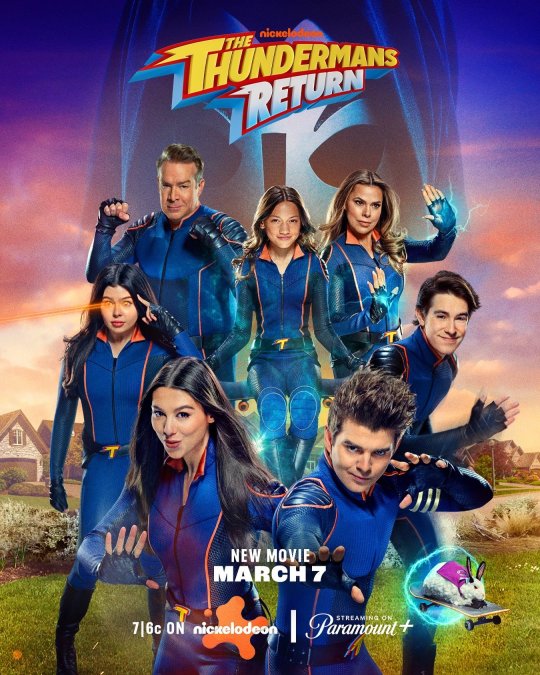
There are two versions (that I found so far) of the poster! BOTH are really, really confusing, but let's analyze!
Let's actually start with the background: it's Hiddenville, which makes sense ("The Thundermans Return" to Hiddenville), but we already know that the movie will take place in various locations, so I really hope we will get to see more of Metroburg (and that it will be included in a poster too). But it's really nostalgic and...strangely it sets a very interesting mood. I can't find the right word for it right now. Especially with the color of the sky. You really know SOMETHING is going to go down this time.
Now about the Thundermans. We have Max and Phoebe at the front: the new supersuits look really cool (especially the gloves!) and we have a standard pose that works well. Just one question: WHERE is the rest of Phoebe's left arm. At first thought she had her left hand on her hip, but obviously not, so this remains a mystery for now 🕵️♂️. Notice how all of the Thundermans are posing slightly differently and only the twins' poses are exactly the same! We -again-see the golden stripes on Max's arm that stand for being one of the captains of the T-Force (formally the Z-force). He also has a device (maybe a smartphone) in the pocket on his leg. In general, it seems that all the individual suits are slightly different (not just the boys and the girls).
(insert deleted comment about Max's new hairstyle here XD)
I want to talk about Billy next, because I just live for how happy he looks. Look at him. He's happy to be there, he looks cool and he's all ready to go! And no, he and the twins are not on a staircase or something - Diego is simply this tall now (and Phoebe and Max are both in a medium squat).
Next we have Nora: she has darker hair now (resembling Phoebe's hair colour) and I really like the pose she does with her left hand to focus her laser. Unfortunately her stance is slightly strange to me (but that's maybe also because Phoebe's elbow is covering half of her leg).
I don't have much to say about Hank and Barb, so let's move on to Chloe, who the center of this whole picture. I'm really intrigued by this. I love her smile and overall expression -she knows exactly what she's doing. AND - after looking at this picture for several minutes- she's sitting on a FLYING skateboard! Then there's a second flying skateboard with Dr. Colosso on top. WHAT is going on!? My first guess: flying skateboard - hoverboard-time travel. I actually made a post once on how Chloe might be able to travel in time due to her teleportation power. For me it makes sense (I will discuss this again on here soon), because it also helps with my theory of Mayhem's return (from the past, where he was more powerful). Also the "Thundermans Return..." return back to the future!?!? 👀
My last point is related to this theory. I saw this poster and thought it was strange (but very cool still!). And I thought it's the arm or leg placement, the composition, but you know what? It's the light. Let me explain: there are lights that comes from the sky, the background, then the ones from their individual superpowers (lasers for Nora, lightning for Barb etc.), but when you look closely at the wider poster, you will see a strange light in front of Phoebe and Max too. It doesn't look like telekinetic waves (which are normally not visible, but we saw them once on screen in the episode "Cape Fear"). Actually, I think this light comes from Chloe! She's in the middle, but creates a circular light (you can't really tell in the small poster, only in the wide version) around the Thundermans! Notice how Max's hand is almost reaching out through something - could it be a portal!?!? That really should be it, because Dr. Colosso is very obviously traveling through a portal as well. So are the Thundermans going back in time to stop their enemies? To stop Mayhem?!
Okay one more thing: the formation of the Thundermans kinda looks like a T and I'm so here for it. I can't wait!!! And I am so happy we got a poster!!!
#the thundermans#the thundermans return#thundermans#thundermans discussion#thundermans theory#THIS IS SO EXCITING =;;;)#new thundermans movie#phoebe thunderman#max thunderman#chloe thunderman#billy thunderman#nora thunderman#thunderfam
20 notes
·
View notes
Text
The Dionysos gallery (4)
We finally reach the end of this long Dionysos series - and after dissecting the myth of Dionysos, we reach the conclusion of this gallery, kindly offered by the French Museum of Wine (you can find it all here).
First, I will include there the various paintings I did not have enough space to add in previous post, two paintings coupled with an analysis section I will loosely translate.
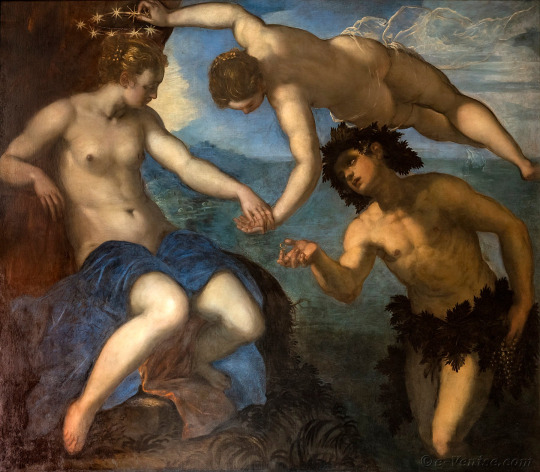
Le Tintoret's Ariadne, Venus and Bacchus
The motif of the encounter between Bacchus and Ariadne (who had been abandonned by Theseus on the island of Naxos) and Bacchus' offer to the woman of her famous gold crown made by Vulcan (according to Ovid's Fasts), has been a strong recurring motif in paintings, explored by numerous artists.
"Liber" or "Liber Pater" was originally a fertility/fecundity god whose worship took place within the oldest era of Ancient Rome. By the 7th century BCE onward Liber was associated with wine, and as a result the Romans ended up assimilating him with Bacchus/Dionysos. "Liber" as such became a mere Latin translation of the terms "Dionysos" or "Bacchus" - "Pater" meanwhile kept its role of expressing respect and adoration towards a god.

Jan van Bijlert's The Feast of the Gods
This 1630 painting currently kept at the Magnin Museum (Dijon) asks a quite troubling question: is this pagan scene... secretly a Christian Last Supper?
We are on Olympus. The gods are gathered for a feast. On the left we see Minerva, Diana, Mars and Venus, with Cupid by their side and Flora behind them. At the center of the table, a crowned Apollo appears holding his lyre. To the right we can recognize Hercules thanks to his mace, and Neptune with his trident. Unfortunately several of the Olympians are missing due to the painting having been cut off: for example there is a peacock, but no side of Juno. The motif of the "feast of the gods" was very popular in Holland, ever since an engraving by Goltzius "The Wedding of Psyche and Love" (see below).
However, van Bijlert's painting can be read very differently. In the Netherlands, due to the appearance and domination of Protestantism, all pictures had been banished from the temples, putting an end to the religious painting. As such, it seems that this painting hides within it a Christian scene of the Last Supper. Apollo at the center has the same halo as the Christ usualy has, and the characters surrounding him are twelve in total like the Apostles. Now, while it is a very interesting theory, we should stay careful. As we said before, it seems the reason some of the gods are missing is because the painting was cut (a practice very common at the time) - again, there's this peacock that implies Juno used to be included. Second element: yes the Christ has a golden halo in painting to symbolize his role as the Lord of the Heavens, but long before that, the idea of a halo of light did belong to Apollo. The Greeks saw him as the "solar god" by excellence, since he was the power that ruled and organized all things, and the one that regulated spirits and intelligences (in fact, he was complementary of Dionysos since Apollo tamed, controlled and shaped the vital force and bursts of life embodied by Dionysos).
Bijlert lived in Rome in the beginning of the 1620s and we know that, just like many of his fellow painters, he was deeply impressed by the art of Caravaggio. However, the Italian painter's fame was dwindling by then - and by the 1630s his art had lost any influence over European paintings. In this decade, Bijlert focused his works on the new international trend, the classicism. Here the composition of the panting and the diurnal luminosity are purely classicist. However, the dancing satyr and the leaning Bacchus on the foreground belong to the "naturalism" of Caravaggio: ocre-colored flesh, close-ups on bodies in non-conventional positions...
(Here is Goltzius' engraving)

Second part of this post, extending from the analysis above: Christianized Dionysos! Because yes, you might be surprised to learn that the motif of Dionysos/Bacchus in classical painting was heavily Christianized or syncretized with Christian figures...
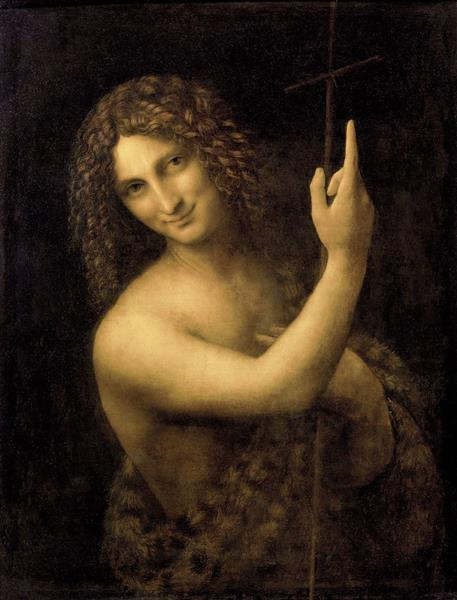
Leonardo da Vinci's Saint John the Baptist
This Saint John the Baptiste has what has been called a "pagan beauty", and this painting with a Tuscany imagery "renews the syncretism of the patron of Florence" - perhaps due to the passion for Antiquity the town had when the painting was created. Indeed, while saint John here holds a cross symbolizing the Passion of the Christ, he is dressed in a panther's skin, reminding of the cloak of Bacchus...

Leonardo da Vinci's atelier: Saint John the Baptist-Bacchus
Once again this painting shows the syncretism between the figure of saint John and the character of Dionysos. The painting was first recorded, in the royal archives, as "Saint John in the desert". However, at the end of the 17th century, perhaps due to a restoration of the painting, the name was changed to "Bacchus in a landscape". Here we have Christian symbols: a finger raised to the sky, a stag resting on the ground... But we also have Bacchic attribute: a thyrsus, grapes, a panther's skin, and a crown of what might be ivy or vine-leaves.

Caravaggio's Saint John the Baptist
Here again we have the attributes of Bacchus: the vine, of which Bacchus was the god, and a ram, an animal traditionally sacrificed for the deity. Historians of painting are agreeing that the reason the Caravaggio associated John the Baptiste with Bacchus was because it allowed him to depict the saint naked, and eroticized, very probably to reflect his own homosexuality.
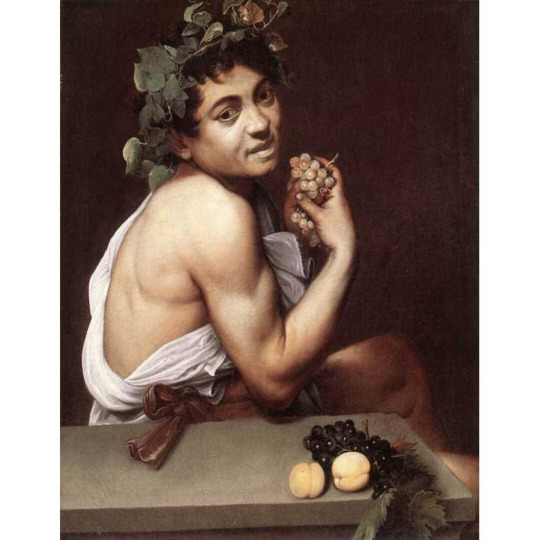
Caravaggio's "Sick young Bacchus/ The ill little Bachus"
This panting of Caravaggio has been interpreted as a self-portrait in a Bacchus-Christ fusion that is very sexual. Here, Caravaggio offers himself to the libertine cardinals of Rome, in an erotic "communion" (remember, "eucharis", means "the good flesh"). The action of carrying to his lips golden grapes gorged with juice is very sensual. Crowned with ivy, dressed in an ancient toga (which reveals a muscular shoulder), he is holding green grapes to his chest, as if he was about to press them. It has been thought that there the Greek wine of Dionysos is a mask or assimilation for the wine of the Christian mass - the invitation is for always a greater feast and bigger celebration, the wine of the Christ "subliming" the wine of Bacchus, ultimately becoming the wine an "universal mass" beyond any religion or era.
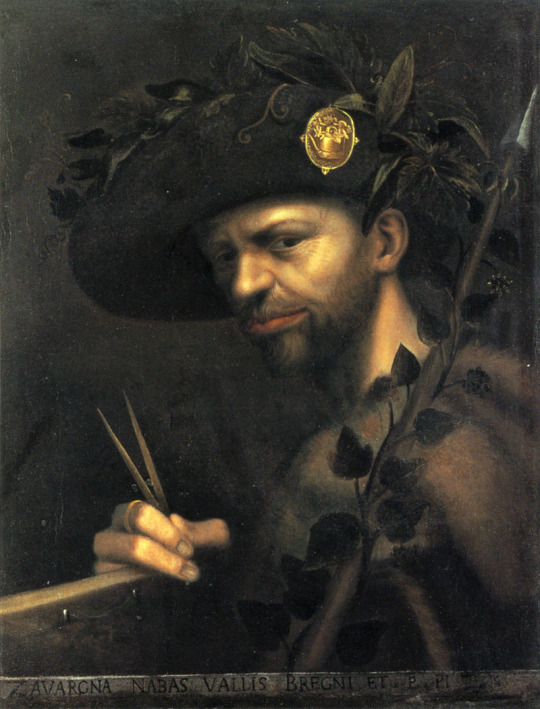
Giovanni Paolo Lomazzo's "Self portrait as a crowned Bacchus"
This painting depicts Giovanni Paolo Lomazzo in his outfit of president (called an "abbot") of the Acacademia della Val di Blenio (Ticino) - Lomazzo had just been named to this function, as the inscription at the bottom of the picture reminds the viewer. The Academy gathered all the best artists of Milan - painters, sculptors, musicians... And it was placed under the protection and patronage of Bacchus, the god that relieves from sorrows and worries, the god that inspires joy, the god that stimulates the mind and the creation, the god that frees from bondage. As such, it explains why this self-portrait has Lomazzo as Bacchus. It was an answer to the many disasters of the era, as well as to the new austerity imposed by the figures of the Counter-Reform - such as Charles Borromée, who was the archbishop of Milan and a cardinal within the Catholic church.
The Bacchic references are numerous here. The hat is wrapped in a garland of laurel and vine, with a medallion depicting vine too. There is a thyrsus surrounded in ivy. And finally there is a goat-skin, reminding of how when he was a child Bacchus was turned into a "kid" (baby goat) to avoid Juno's wrath. The compass however within the man's hand is not a symbol of Bacchus. Held like a paint-brush, it is meant to symbolize how Lomazzo "leads" and "drives" his own career like a captain would pilot his ship.
#the dionysos gallery#the art of the myth#dionysos#dionysus#bacchus#syncretism#saint john#john the baptist#art#painting#folk christianity#christian art
19 notes
·
View notes
Text

A Sunday Afternoon on the Island of La Grande Jatte
Artist: Georges Pierre Seurat (French, 1859-1891)
Subject: People relaxing at la Grande Jatte in Paris
Date: 1884-1886
Medium: Oil on Canvas
Location: Art Institute of Chicago, Chicago, Illinois
A Sunday Afternoon on the Island of La Grande Jatte (French: Un dimanche après-midi à l'Île de la Grande Jatte) was painted from 1884 to 1886 and is Georges Seurat's most famous work. A leading example of pointillist technique, executed on a large canvas, it is a founding work of the neo-impressionist movement. Seurat's composition includes a number of Parisians at a park on the banks of the River Seine. It is held in the collection of the Art Institute of Chicago.
Background
Georges Seurat painted A Sunday Afternoon between May 1884 and March 1885, and from October 1885 to May 1886, focusing meticulously on the landscape of the park and concentrating on issues of colour, light, and form. Seurat completed numerous preliminary drawings and oil sketches before completing his masterpiece.
Inspired by optical effects and perception inherent in the color theories of Michel Eugène Chevreul, Ogden Rood and others, Seurat adapted this scientific research to his painting. Seurat contrasted miniature dots or small brushstrokes of colors that when unified optically in the human eye were perceived as a single shade or hue. He believed that this form of painting, called Divisionism at the time (a term he preferred) but now known as Pointillism, would make the colors more brilliant and powerful than standard brushstrokes. The use of dots of almost uniform size came in the second year of his work on the painting, 1885–86. To make the experience of the painting even more vivid, at the paintings edge, he surrounded it with a frame of painted dots, which in turn he enclosed with a pure white, wooden frame, which is how the painting is exhibited at the Art Institute of Chicago.
The Island of la Grande Jatte is located at the very gates of Paris, lying in the Seine between Neuilly and Levallois-Perret, a short distance from where La Défense business district currently stands. Although for many years it was an industrial site, it has become the site of a public garden and a housing development. When Seurat began the painting in 1884, the island was a bucolic retreat far from the urban center.
The painting was first exhibited at the eighth (and last) Impressionist exhibition in May 1886, then in August 1886, dominating the second Salon of the Société des Artistes Indépendants, of which Seurat had been a founder in 1884. Seurat was extremely disciplined, always serious, and private to the point of secretiveness-for the most part, steering his own steady course. As a painter, he wanted to make a difference in the history of art and with La Grande Jatte, Seurat was immediately acknowledged as the leader of a new and rebellious form of Impressionism called Neo-Impressionism.
#sunday relaxation#oil painting#sunday#paris#artist george seurat#french artist#island#parisians#river sienne#park
7 notes
·
View notes
Text
A Little Legendborn/Bloodmarked Scent Theory Part Two
William Sitterson scent profile - Citrus/Fresh
“The infirmary is William’s domain. He strides between the tables, his hands coated in silver aether so thick it looks like mercury. The bright citrus smell of his aether signature fills the room.”
What can I say, I love William and his sunny, yet firm disposition. Fruit in the citrus family include oranges, lemons, limes, grapefruit, kumquat, clementine, pomelo…you get the idea.
Citrus - Citrus oils and resins have the power to uplift our mood and bring peace to a space. Think of all the household cleaners you use, how many of them have a citrus profile? Ever wonder why you gravitate towards those scents? Citrus has been used in many cultures for centuries and has healing and therapeutic benefits. It is no wonder William is one of the few people that can calm Sel down in the heat of anger. He is like a gray-eyed Yoda, even-keeled and level. His tranquil sensibilities allow people to put their guard down and open up that much more. The history of the use of citrus in Ayurvedic medicine in India or in religious ceremonies in ancient Egypt is well documented for its ability to purify a space, bringing positive energy which promotes healing. The sweetness of this scent can reduce stress and anxiety.
My final cute William tidbit can be found in this quote:
“After a while, William hands me a lime-colored cloth handkerchief. I stare down at it, puzzled at the alarmingly bright fabric. I hear the smile in his voice. ‘It was my father’s. The line of Gawain is what discerning people call ��ostentatious’.”
Limes - Limes and their oil represent the ability to cleanse the physical body and heal and purify the soul. Next time you are at Tarjay’, grab some of that lemon/lime-scented Mr. Clean and thank the Scion of Gawain.
Valechaz' scent profile - Soft Oriental, Dry Woods
“He leans into me slightly, and I get a whiff of something dark, spicy, and burning.”
“He steps nearer, until that leather and star-anise smell swirls thick in the air and my cheeks prickle.”
Valechaz’ scent profile is as spicy and sensual as he is. In my reading, I found that his scent calls back to a time of old (much like Incense Daddy Erebus, but more on that later) which is fitting for the 205 year-old most balanced Cambion in the region.
Leather- When used in perfume, leather scents are warm and rich, with a bit of musk. There are smoky and animalistic notes. Valec’s scent was described as burning (we know he brings the heat with him) and the way his eyes turn over red reminds me of a shark whose eyes turn over white before it bites. The scent of leather denotes luxury, sophistication, and masculinity (whatever that means to you). We know Valec is dressed to the nines daily, “Suited and booted” as the old folks used to say. He is also not to be trifled with as he has demonstrated he is 100% with the shits.
Star Anise- Sweet and licorice-y (yes, that is a word), star anise is spicy and intense. It is rich and exotic and is often added to oriental and gourmand fragrance compositions. Star anise compliments a variety of fragrances creating harmonious blends that have endless layering possibilities. Its presence enhances the overall scent, creates depth and complexity, and enables the creation of balanced, captivating fragrances.
The essence of Valec’s scent profile is luxurious, seductive, and balanced on the razor’s edge of ferocity.
Erebus Varelian- Scent Profile Woody Oriental or Woody Amber
“His aether signature surrounds me with scents I associate with ancient trees and holy places: myrrh and saps, incense burning.”
Erebus (affectionately known as Incense Daddy) is such an interesting and mysterious being. He is calculated and opportunistic, and I imagine he has not survived this long without brutal and unwavering tact and a bit of street smarts. His scent hints at his true identity and the power that lives within it.
Incense - Spicy, resinous, and woody, the smell of incense creates a mysterious, warm, richly scented experience. For eons incense has been used in cultural and religious practices dating back to ancient Egypt, China, and India. Its spicy, powdery notes are seductive (like Valechaz’) and smelling incense when none is present can denote spiritual presence or messages from the spiritual realm. Incense can be associated with protection and spiritual growth.
Myrrh - Myrrh tends to go hand in hand with incense. It is described as having a balsamic, spicy, smoky odor. Made from bleeding a Commiphora tree of its resin, in magical circles, myrrh is used with cleansing and purification rituals. It can also be combined with incense for protection against negative energy and rituals related to banishing and breaking curses.
It is no wonder Erebus’ scent is derived from tree resin. Trees hold powerful ancient symbolism (strength, growth, protection) and represent an interconnectedness of all living things. Erebus has been around the block in many iterations, hiding in plain sight. His scent profile calls back to a time when Gods walked amongst men.
“Dark hair, olive skin, a long black jacket, and an aether signature older than the ancients themselves. How many people has he killed, just to walk among us?”
I hope you’ve gotten a kick out of this as I have! What did you notice about the scent families? How do you think they are connected? I have linked part one below as well as my other contributions to this fun little series. Now go on out there and find an "Incense Daddy" to smell.
Scent Part One
Color Theory
Symbolism
19 notes
·
View notes
Text
Akiridion Evolution
I'm back on my bullcrap, here's the next installment of Mad's Akiridion Analyses! Compilation of these posts is linked at the bottom.
ALRIIIIIGHT part 3! Boy howdy have I got theories!
First of all, we aren't told how much time passed between when Gaylen created Akiridion and when Seklos defeated him. Given how easy it was to replicate Seklos' cannon with scrounged ET tech and what was available on Earth, we can assume the confrontation happened a long, long time ago- Akiridion ships have been able to reach Earth since the earliest humans were around.
I think that, originally, the first Akiridions actually lived on the moons orbiting the planet. It would explain why they handle the atmosphere on Earth's moon (Luna, I'll be calling her) so well when Akiridion-5 itself apparently has oxygen "in abundance". Given the fact Akiridions have respiratory systems, as mentioned by Stuart (and the fact we can see them breathing), it would be logical to assume they evolved or were created by Gaylen without the planet's atmospheric composition- otherwise, their respiration would take advantage of oxygen.
Additionally, the planet itself appears to be a gas giant, which is backed up by the lack of any semblance of trees on Akiridion as mentioned by Aja (though this can be explained just as easily by "different planets, different life forms"). Their cities seem to float among clouds, which would take a certain level of technological advancement far beyond what a budding species could manage. Also, the royal palace and its surrounding capital city are on the planet itself, indicating that it takes a higher level of power and technology to build there- royalty tend to set up residence where it'll be most impressive and hardest to reach (not hard enough tho, huh? Rip Coranda and Fialkov).
Moving on. The use of a number after the name of a planet usually indicates distance from the sun in science fiction, which would mean Akiridion is the fifth planet from its sun. This makes sense given the fact we never actually see the sun Akiridion is orbiting; it's always what we humans would consider nighttime there, and Aja and Krel mention "Earth's blue sky" as something new and strange, even as they say the color reminds them of home. Maybe it's a pretty spread out solar system. Maybe there's an asteroid belt or dust clouds or other things between Akiridion-5 and its sun that block visible light from reaching them. Heck, maybe it's a binary or blue star system and that's why the planets have to be so far away from the center of the solar system to be habitable (though, blue stars tend to be shorter-lived, as I recall, which doesn't lend to the idea of Akiridion-5 being absolutely, ridiculously ancient). Either way, it would seem logical that Akiridions have a significant resistance to cold as well as radiation, but not so much heat. It would also seem logical that Akiridions don't really have rain, at least not the way Earth does. Fic about the very first time Aja and Krel saw rain when- jkjk (unless?).
Personally, I'd think it's super neat if Akiridion-5's solar system is right on the edge of a massive nebula, leaving the planet shrouded in the gasses and clouds for part of their kelton. The combined darkness and bright colors of Earth's winter and holidays would likely remind Aja and Krel quite strongly of home.
See what I mean? Totally a gas planet.

12 notes
·
View notes
Text
Yvette Heiser-Photography Tips for Achieving Color-Perfect Self-Portraits
In the age of social media and personal branding, self-portraits have become a powerful way to express identity, creativity, and style. However, capturing the perfect self-portrait goes beyond simply pointing the camera at you. As highlighted in Yvette Heiser’s Shutter and Spice: Mastering Photography in the Lone Star State, achieving color perfection in your self-portraits can significantly impact how your photos are perceived, transforming them from ordinary snapshots into professional-quality images. Here are some essential photography tips to help you master the art of color-perfect self-portraits..

Understand Color Theory
Before diving into the technical aspects, it's crucial to grasp the basics of color theoryFamiliarize yourself with the color wheel, grasp the concept of complementary colors, and experiment with various color harmonies. This knowledge will help you make informed decisions about your background, clothing, and overall composition to create visually appealing self-portraits.
Choose the Right Lighting
Lighting is crucial for capturing accurate colors in your self-portraits. Natural light is often the best choice for capturing true-to-life colors. Try shooting near a large window or outdoors during the golden hour (just after sunrise or before sunset) for soft, flattering light. Avoid harsh midday sun, which can create unflattering shadows and wash out colors.
Use a Color Checker Card
Invest in a color checker card to ensure color accuracy across different lighting conditions. This small, portable tool contains a series of color swatches that you can include in a test shot. During post-processing, you can use the color checker as a reference to adjust your white balance and color settings accurately.
Set Custom White Balance
Most cameras provide the ability to adjust and customize the white balance settings.. This feature helps neutralize color casts caused by different light sources. Photograph a white or gray card in your shooting environment and use this image to adjust your camera's custom white balance settings. This step ensures that your camera interprets colors correctly for your specific lighting situation.
Shoot in RAW Format
Shoot your self-portraits in RAW format rather than JPEG.. RAW files preserve more color data and offer enhanced flexibility during post-processing. This format enables you to fine-tune white balance, exposure, and color tones while maintaining the highest image quality.
Pay Attention to Your Background
The colors in your background can significantly impact the overall look of your self-portrait. Choose backgrounds that complement your skin tone and outfit. Steer clear of backgrounds with overly saturated or conflicting colors that could draw attention away from you as the focal point.
Experiment with Color Gels
To add a creative touch to your self-portraits, consider applying color gels to your light sources. These translucent, colored sheets can introduce captivating hues to your photos and generate distinctive color effects. Play around with various gel colors to discover combinations that complement your skin tone and elevate your visual style.
Use a Color-Calibrated Monitor
Ensure that your computer monitor is color-calibrated for accurate post-processing. A calibrated monitor displays colors as they truly are, allowing you to make precise adjustments to your self-portraits. Invest in a monitor calibration tool for the best results.
Master Post-Processing Techniques
Learn to use post-processing software like Adobe Lightroom or Capture One to fine-tune your colors. Adjust white balance, tint, saturation, and individual color channels to achieve the perfect look. Be careful not to over-edit, as this can lead to unnatural-looking skin tones.
Consider Your Wardrobe
The colors you wear can greatly impact the overall harmony of your self-portrait. Select clothing colors that enhance your skin tone and align with the mood you wish to express. Solid colors often work best, as patterns can be distracting in self-portraits.
Practice Color Grading
Develop your color grading skills to give your self-portraits a consistent and professional look. Experiment with different color grading techniques to create a signature style that sets your images apart.
Seek Inspiration from Color Palettes
Look for inspiration in color palettes from nature, art, or design resources. These can guide you in creating harmonious color schemes for your self-portraits, from your outfit choice to the background and overall mood of the image.
By implementing these tips and techniques, you'll be well on your way to capturing color-perfect self-portraits that truly showcase your unique style and personality. As Yvette Heiser highlights in Exploring Beyond Reality with Color-Perfect Self-Portraits, mastering color in photography is an ongoing process, so don’t hesitate to experiment and develop your own aesthetic. With practice and attention to detail, you'll soon be creating stunning, color-rich self-portraits that stand out in any portfolio or social media feed.
#photographer#camera#wedding#photography#moments#yvette heiser#pictures#childphotography#photographytips#events#Yevette Heiser
3 notes
·
View notes
Text
UN Village and City Lights by Baekhyun
MV and album discussion
UN Village by Baekhyun
The title song and mv is well comprised because it shows Baekhyun's vocal color and his power in exo (light). To me, it felt like Baekhyun has been hiding from too much light, aka from showing too much of his power (you will know what I mean if you look up for exo's theory and Baekhyun's role in that concept in Tumblr: @adoringdo). The R&B song itself however talks about spending a special time with the beloved in Hannamdong UN Village hill. He wishes that the beloved speaks their true love to him and enjoys the particular lovely moment with each other. The composition of the background score features unique heavy sounds arranged in a way that it becomes subtly emphasized. The sound makes us get into the song, makes us question that let me see how this song continues to sound like, and then comes Baekhyun's first line "Navigation 독서당어린이공원으로 누르고 엑셀을 밟아" (Navigation to Deokseodang Children's Park press start and step on the gas). The line is something one would not expect to be uttered in an R&B song in the very first line. Nevertheless, Baekhyun's accentuation made the line sound so subtle and natural that it felt easy-going. I personally found verse 2 (1:34) to be compelling because Baekhyun's voice sounds like it is heard from a radio (if you know how to explain this more accurately please let me know).
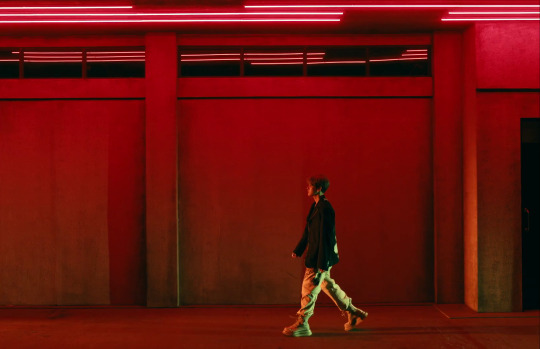
Moreover, the flow is different there than the rest of the song, it gives a lo-fi feeling. The background sound also sounds different than the rest in this part. The scenes from (1:34) to (1:56) went perfectly with verse 2. The high notes and long notes in this song seem to function with the tone of emphasis upon the lover's wish and longing for love.
The overall aesthetic the mv seems to be going for is the same, subtle but special. It emphasizes the flowing whispering love the singer sings about. The mv also has a light seductive side to it, which could be seen through the noir vibes (walking through darkness, black and white, serious looks, buildings, roads), play on different colored lightings (blue, red, white, yellow, green), close up shots of Baekhyun. The flow of different scenes were really good. I just found some of the black and white shots to be unnecessary(again, if I could know the Director's reasoning behind it that would've been cool). For example (0:31), (2:58, 2:53), (2:20)- because I would have liked to see scenes with actual city lights.

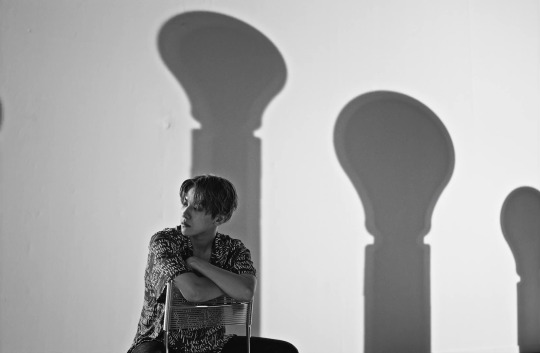
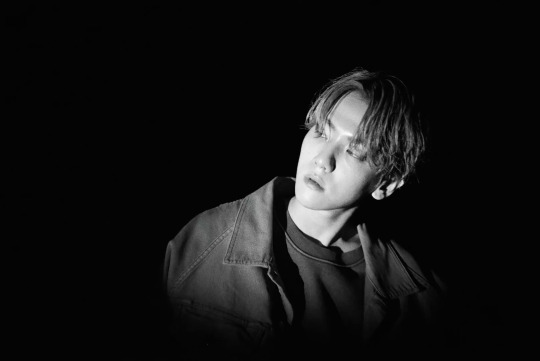
I assume the director added these scenes either to not make the mv too much noir or to match the lyrics, or to make the mv more nostalgic and melancholic (could be anything idk). Also, please let me know what you understand from the last scene where Baekhyun is lying on a table and a woman passes by, I have no idea.
My most favorite shots have been
1. Blue hues with blueish Baekhyun (1:46) (1:50) (2:35)



2. The projection on the surface of the building (3:42). The cut to the projection from actual video (2:44-2:50)


3. 0:49 going through that corridor (black and white with play on lighting)

4. The play of red and white lighting, Baekhyun's cool fit (2:22- 2:27) (2:38) (3:07- says turn the light off (lighteul kkeo) and the white light turns off)
5. Every black and white scenes shot in/with that building, especially on (0:56) (1:00) (3:16)



The other songs in the album:
Diamond: The layering with Baekhyun's voice sounds really catchy in the chorus. The song goes well after UN village as it has almost the same theme. It sings about wishing to be more close and intimate together, desiring to explore more of the beloved. To his eyes, the beloved shines like a diamond when they stand next to the lover.
Betcha: The girl does not care or pay enough attention yet. However, the lover is determined to win her over. The guy is confident enough about that. The song has a playful and confident tone into it. Betcha also has a playful dance with it which you'll find in SMP Floor, Baekhyun and Haechan also did challenges with it.
Ice Queen: The transition from Betcha to Ice Queen is smooth, as if Ice Queen is the next part of Betcha. The lyrics here are more descriptive than Betcha. The lover invites the ice queen girl to feel his warm heart with her cold hands. The lover has the warmth and passion of love reminiscent of fire, which is the opposite of the ice queen. The lover wishes to evaporate and get lost into the reaction of their love. Other EXO-L's said that the beginning of Baekhyun's Ice Queen has the same sample as JB's Sunrise, so that's something to note. I love the ending, where he shouts "On my way!"
Stay Up: Well, ahem this one's gonna be a bit racy. It delves into doing amorous activities together. Almost towards the end of City Lights, the lovers are about to take off into next level. This city night resembles the beloved since the beloved is lonely and puzzled, and extravagant, the same as the city streets. Beenzino's parts were natural and embedded with the song well. The sing was produced by well-known producer Cha Cha Malone. Many aeries were shocked to have matured lyrics sung by Baekhyun, which I can relate because he has such a cute face which deludes us into thinking that he is not 27 already by then XD. The lover wishes to go for the third base as the lyrics says "Baby we can stay up, Throw you at me, to the deepest point fall in love...Get in there, reachable lips...I'll fill your empty heart full of me. No sleep tonight. We makin' love. Until the sun shines down on us...Baby lay back. Close your eyes. I'd like to get drunk on you sweet. I'll go easy on you. We can go on and on tonight."(say what?!) Baekhyun makes smut sound like poem, he has such an affectionate yet seductive voice. [*slaps myself for simping over his voice] The ending was nice with "On and on..." but I feel this line should've been longer, the gentle vocal in this part was impeccable. Actually, the lyrics were not overtly explicit, it describes the intimation gently without making it obvious, which is why I commend it.
Psycho: EXO always have had two sides to their love. In one love, the lover becomes a monster or Jekyll, in another, the lover falls into a deep obsession. In this album, the love that started as being playful where the girl did not pay attention at first (in betcha), ended up being psychotic. I would recommend y'all check out Bebe's cover of this song in Street Woman Fighter 2, it's too good, and I'm glad she covered it, she accurately choreographed according to the lyrics and feelings if this song. Baekhyun said on his City Lights showcase that Psycho is about a toxic relationship. While reading the comments, I came across some theories by aeries, which I appreciate. Some linked it to DID, some compared the light exol- healthy relationship and dark exol(or not)- toxic. There is a push and pull going on in the lyrics. On one hand, the lover wishes for the beloved to stay because he needs her, on the other he hopes she goes away because of his dual personality.
The name of the album City Lights is apt. The loneliness, dark and light theme, a romantic night in the city are all featured in the songs using different metaphors and meanings. However, I loved the album cover so much where Baekhyun is on top of a car in an evening over the road where the city lights are shining. So, I would've loved it more if the concept teaser, teaser photos and/or the mv featured more of that image.


Now that it's 2024, we know that we saw some nice mv's that features such nighttime imagery. For example, Baekhyun's Bambi and Minho's Heartbreak.
City lights imagery in Baekhyun's Bambi:


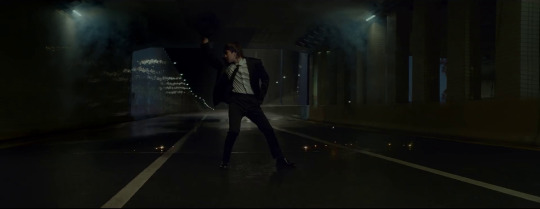
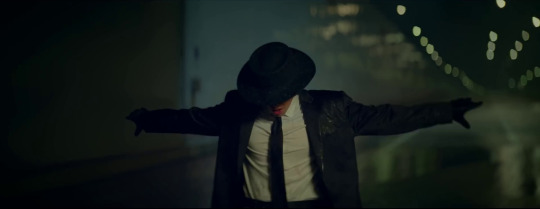
City Lights imagery in Minho's Heartbreak MV:

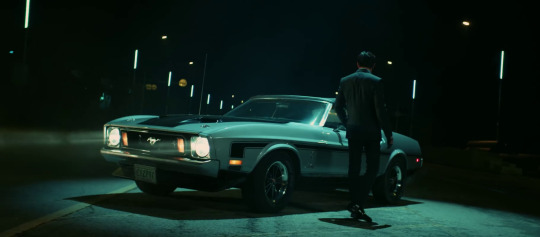
Give a listen to Baekhyun's City Light, Bambi, and Shinee Minho's Heartbreak!
~Just Apple Pie
2 notes
·
View notes
Text

A Sunday Afternoon on the Island of La Grande Jatte
Artist: Georges Pierre Seurat (French, 1859-1891)
Subject: People relaxing at la Grande Jatte in Paris
Date: 1884-1886
Medium: Oil on Canvas
Location: Art Institute of Chicago, Chicago, Illinois
A Sunday Afternoon on the Island of La Grande Jatte (French: Un dimanche après-midi à l'Île de la Grande Jatte) was painted from 1884 to 1886 and is Georges Seurat's most famous work. A leading example of pointillist technique, executed on a large canvas, it is a founding work of the neo-impressionist movement. Seurat's composition includes a number of Parisians at a park on the banks of the River Seine. It is held in the collection of the Art Institute of Chicago.
Background
Georges Seurat painted A Sunday Afternoon between May 1884 and March 1885, and from October 1885 to May 1886, focusing meticulously on the landscape of the park and concentrating on issues of colour, light, and form. Seurat completed numerous preliminary drawings and oil sketches before completing his masterpiece.
Inspired by optical effects and perception inherent in the color theories of Michel Eugène Chevreul, Ogden Rood and others, Seurat adapted this scientific research to his painting. Seurat contrasted miniature dots or small brushstrokes of colors that when unified optically in the human eye were perceived as a single shade or hue. He believed that this form of painting, called Divisionism at the time (a term he preferred) but now known as Pointillism, would make the colors more brilliant and powerful than standard brushstrokes. The use of dots of almost uniform size came in the second year of his work on the painting, 1885–86. To make the experience of the painting even more vivid, at the paintings edge, he surrounded it with a frame of painted dots, which in turn he enclosed with a pure white, wooden frame, which is how the painting is exhibited at the Art Institute of Chicago.
The Island of la Grande Jatte is located at the very gates of Paris, lying in the Seine between Neuilly and Levallois-Perret, a short distance from where La Défense business district currently stands. Although for many years it was an industrial site, it has become the site of a public garden and a housing development. When Seurat began the painting in 1884, the island was a bucolic retreat far from the urban center.
The painting was first exhibited at the eighth (and last) Impressionist exhibition in May 1886, then in August 1886, dominating the second Salon of the Société des Artistes Indépendants, of which Seurat had been a founder in 1884. Seurat was extremely disciplined, always serious, and private to the point of secretiveness-for the most part, steering his own steady course. As a painter, he wanted to make a difference in the history of art and with La Grande Jatte, Seurat was immediately acknowledged as the leader of a new and rebellious form of Impressionism called Neo-Impressionism.
#sunday relaxation#oil on canvas painting#sunday#paris#artist george seurat#river sienne#park#coiffeur#parisian#french artist
4 notes
·
View notes
Text
Thoughts on Fashion Dreamer Day 1
Since the game received close to no marketing outside of Japan. I love fashion games and I want this one to do well too.
I played all the Style Savvy games before (almost 300 hours on each of then oof) but I ll try not to compare with Fashion Dreamer too much since the concept is different.
Apologies in advance for the mistakes (English is not my mother tongue)
What I like so far:
- Getting lookits from other players and giving some to them! I love seeing everyone's creativity
- There's SO many options to design a logo!! I spent too much time making them haha
- Visiting other's showrooms feels fluid. Its fun to just change try an outfit on a mannequin and walk to another showroom, like a carousel.
- The photo mode offers a lot of options. I like being able to take a picture anywhere. Also you can take vertical pictures for a better composition! Or just use the random button to have your muse in a dynamic pose.
- I love the idea of unlocking color palettes and using them to design clothes. There's some color theory in there... Also having reommendations is nice for indecisive people.
- It's rewarding to see the earrings I designed on the trends board. Then I found them again on a mannequin in another muse showroom. My muse tried the whole outfit (that was styled to match the the earrings I designed) and it was SUPER cute! I took pictures to remember that moment. I dont think there's any game that offers this kind of experience.
- Not having to manage a budget and getting items for free it is a fashionista dream haha.
- The animations and the models look nice! I was also afraid of EVE looking cold and empty (like the EDEN in Digimon Cybersleuth) but I was pleasantly surprised. I also havent seen anything clip though the models? (Anyone an expert on that lol?)
What I like less:
- Search function could be better. I want to be able to search by pattern and color!
- There's a bit of a performance issue when you have a lot of clothes. Hope this gets fixed in the future.
- Not being to zoom in clothing when dressing up is... Odd. Because you can zoom on the ones you design.
- Its super easy to get likes (I dont know if its the case for everyone). What bothers me is you get a notification for EACH likes. Im the kind of person that deacrivates most of my notifs on my cellphone because I find them intrusive.
- I hope they add runways, handbags and the possibility to share pictures with other players. And it would be fun to suggest makeup or hairstyles to other muses!
Game is pretty addicting, Im gonna play more for sure. I really needed a good fashion game for the Switch!! Its not Style Savvy but if I miss it too much, I can always power up my 3ds.
Maybe I ll write another post about Fashion Dreamer as I play more. Who knows :p Dont hesitate if you have questions!
9 notes
·
View notes